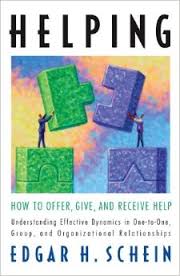 Leading is a lot more to do with accepting and giving help than we often realise.
Leading is a lot more to do with accepting and giving help than we often realise.
Many of us carry in our heads an image of how leaders should behave that is at odds with how people actually influence us (aka lead us). Our model for leadership is rooted in a presumption that they should have specific expertise and knowledge that followers do not possess – a sort of unique secret sauce! After all – this is how they became a leader and hence why they should not need help, isn’t it?
Yet even a cursory amount of thought should challenge our assumptions – not least if you look at the way we all resist ‘leadership’ provided from this perspective. Most leaders will readily admit that in many situations in their organisation they do not have the best expertise to solve an issue. Even in knowledge-based organisations the leaders are rarely those with the most knowledge or insight.
Yet we persist in our assumptions – and the result is that leaders come to their roles often with same assumption. Somehow being helped and being a leader does not sit comfortably. But those leaders who learn how to receive (and give) help well will perform much more effectively.
Leading is a lot about effective helping
The most successful form of influence is that which is perceived as help by those being led: where the follower is a kind of ‘client’ who is assisted to achieve their goals. This is even true when mandatory change is needed. Atul Gawande in his book ‘Better’ recounts the case of persuading medical staff to wash their hands more frequently to improve hospital hygiene. A clear policy with carrots and sticks achieved at best perfunctory compliance despite the essential nature of the change. It was not until doctors (leaders in the hospital but followers in this change) were really asked why hand-washing was problematic that a combination of approaches created success – including more and more convenient washing points and using gels that reduced the time taken to cleanse hands. In effect the goal was reached when doctors were helped to achieve the goal and not before.
In all organisations leaders need to lead leaders – hence why many would say that the best leaders are also those who know how to follow well.
I have always been very interested in the dynamics of giving and receiving help. It is at the heart of effective consulting and at the centre of the sort of teamwork that makes or breaks the resolution of most marketing, strategy or organisational issues. Effective teams, by their very nature, demand fluid giving and receiving of help. So with the benefit of a recent break and ample time to catch up on reading I was able to read a book on the topic, by one of my favourite academics on leadership and culture, Edgar Schein. ‘Helping’ builds on much of what he has previously written on process consulting but has a more general focus and therefore is even more accessible.

The book duplicates some of what he has written elsewhere but is nonetheless a perceptive and useful analysis that highlights some valuable principles and tips and when I read, “….leaders must first learn to accept help themselves….and must become helpers to the organisation they are trying to influence,” it seemed worth a blog post.
Receiving help is tough
Schein points out that asking for help has a psychological impact on us. It generates anxiety, as we expose our vulnerability. In effect it places us ‘one step down’ from our potential helper – in a position of dependency.
This shapes the initial dynamics of any discussion. Unless handled well by the helper it can lead to a very unproductive interaction. Think of – calls to helplines, advice from a sales assistant, or a favour asked from a friend. Recall how many times you have found the ‘help’ to be less than helpful – things that you’ve tried before, a simplistic answer to an issue, or irritating or downright patronising. These are traps that are easy for helpers to fall into and Schein is adept at explaining why.
Such experiences and this anxiety probably account for our reticence in seeking help. Yet if, as leaders we understand and can effectively coach others to help us effectively, we can start to improve our own giving of help – and hence our influence. Such skills are vital if success demands as a precondition that each party is ready to give or receive help, as in the hospital example above.
Key lessons for leaders
For me the most memorable lessons in the book include:
- How readily we picture in our minds eye a helper as either an expert who can provide a specific service or piece of knowledge (think engineer or teacher) or as a doctor who should diagnose the issue and make informed recommendations. Neither of these mental pictures are the most useful ones to start off with let alone for addressing the complex organisational issues that leaders typically handle. A much more effective starting model is the ‘process consultant’. The move to one of the others should only be consciously adopted once we are sure that it suits the situation.
- The reminder that effective help takes place only when both parties are ready to give and receive help and not before. This is an emotional readiness. Getting to this starting position needs both relationship and task issues to be addressed first.
- The value that this ‘process consultant’ mindset provides in making a helping interaction effective: the focus on accurate understanding of the issue; equalising the power balance between helper and helped; and creating the conditions to explore problems together. It is a powerful mix.
- The need to start any helping interaction with what Schein calls ‘pure inquiry’ which means that the helper needs to start with as few assumptions as possible and ‘access their ignorance’. This helps to redress the power imbalance that exists at the start of the discussion and ensures effective communication of what the problem is and what shape it has. It empowers the ‘client’ to retain ownership of the problem and play fully their role in its resolution.
- The immense value of asking for feedback on what is and is not helpful – especially early on but also periodically. This is the best way to check that the helping model we are using is the most useful one for the person being helped and that what we doing is working.
Conclusion
The book is a great reminder of some basics for effective influence and for offering real value in any role. It reminded me of the need to recognise my own attitude (and reluctance) to being helped and to use the insights that can be gained from this to make sure that I approach leading and securing commitment not just with the right attitude but also with the right tools and skills to unlock a positive impact.
Maybe when I am next lost, I will not so readily wait for access to Google maps rather than asking someone who may have local knowledge…?
* ‘Helping’ by Edgar Schein p129
